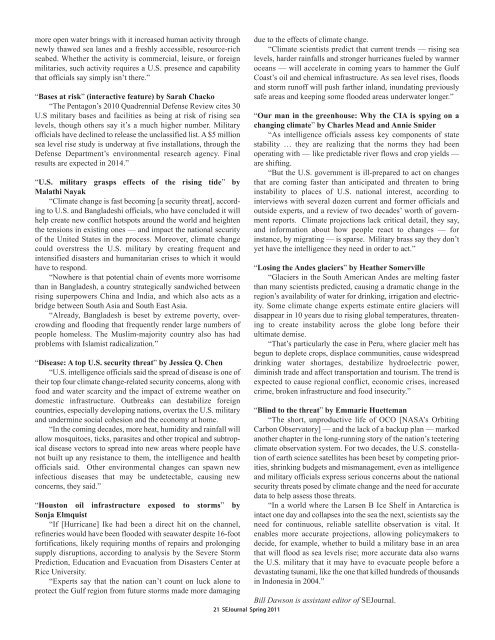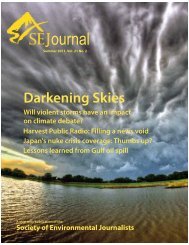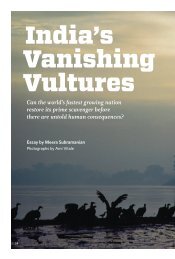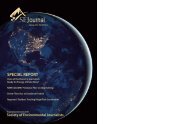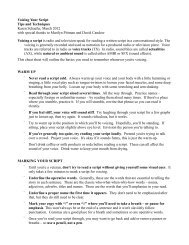PDF Download - Society of Environmental Journalists
PDF Download - Society of Environmental Journalists
PDF Download - Society of Environmental Journalists
Create successful ePaper yourself
Turn your PDF publications into a flip-book with our unique Google optimized e-Paper software.
more open water brings with it increased human activity through<br />
newly thawed sea lanes and a freshly accessible, resource-rich<br />
seabed. Whether the activity is commercial, leisure, or foreign<br />
militaries, such activity requires a U.S. presence and capability<br />
that <strong>of</strong>ficials say simply isn’t there.”<br />
“Bases at risk” (interactive feature) by Sarah Chacko<br />
“The Pentagon’s 2010 Quadrennial Defense Review cites 30<br />
U.S military bases and facilities as being at risk <strong>of</strong> rising sea<br />
levels, though others say it’s a much higher number. Military<br />
<strong>of</strong>ficials have declined to release the unclassified list. A $5 million<br />
sea level rise study is underway at five installations, through the<br />
Defense Department’s environmental research agency. Final<br />
results are expected in 2014.”<br />
“U.S. military grasps effects <strong>of</strong> the rising tide” by<br />
Malathi Nayak<br />
“Climate change is fast becoming [a security threat], according<br />
to U.S. and Bangladeshi <strong>of</strong>ficials, who have concluded it will<br />
help create new conflict hotspots around the world and heighten<br />
the tensions in existing ones — and impact the national security<br />
<strong>of</strong> the United States in the process. Moreover, climate change<br />
could overstress the U.S. military by creating frequent and<br />
intensified disasters and humanitarian crises to which it would<br />
have to respond.<br />
“Nowhere is that potential chain <strong>of</strong> events more worrisome<br />
than in Bangladesh, a country strategically sandwiched between<br />
rising superpowers China and India, and which also acts as a<br />
bridge between South Asia and South East Asia.<br />
“Already, Bangladesh is beset by extreme poverty, overcrowding<br />
and flooding that frequently render large numbers <strong>of</strong><br />
people homeless. The Muslim-majority country also has had<br />
problems with Islamist radicalization.”<br />
“Disease: A top U.S. security threat” by Jessica Q. Chen<br />
“U.S. intelligence <strong>of</strong>ficials said the spread <strong>of</strong> disease is one <strong>of</strong><br />
their top four climate change-related security concerns, along with<br />
food and water scarcity and the impact <strong>of</strong> extreme weather on<br />
domestic infrastructure. Outbreaks can destabilize foreign<br />
countries, especially developing nations, overtax the U.S. military<br />
and undermine social cohesion and the economy at home.<br />
“In the coming decades, more heat, humidity and rainfall will<br />
allow mosquitoes, ticks, parasites and other tropical and subtropical<br />
disease vectors to spread into new areas where people have<br />
not built up any resistance to them, the intelligence and health<br />
<strong>of</strong>ficials said. Other environmental changes can spawn new<br />
infectious diseases that may be undetectable, causing new<br />
concerns, they said.”<br />
“Houston oil infrastructure exposed to storms” by<br />
Sonja Elmquist<br />
“If [Hurricane] Ike had been a direct hit on the channel,<br />
refineries would have been flooded with seawater despite 16-foot<br />
fortifications, likely requiring months <strong>of</strong> repairs and prolonging<br />
supply disruptions, according to analysis by the Severe Storm<br />
Prediction, Education and Evacuation from Disasters Center at<br />
Rice University.<br />
“Experts say that the nation can’t count on luck alone to<br />
protect the Gulf region from future storms made more damaging<br />
due to the effects <strong>of</strong> climate change.<br />
“Climate scientists predict that current trends — rising sea<br />
levels, harder rainfalls and stronger hurricanes fueled by warmer<br />
oceans — will accelerate in coming years to hammer the Gulf<br />
Coast’s oil and chemical infrastructure. As sea level rises, floods<br />
and storm run<strong>of</strong>f will push farther inland, inundating previously<br />
safe areas and keeping some flooded areas underwater longer.”<br />
“Our man in the greenhouse: Why the CIA is spying on a<br />
changing climate” by Charles Mead and Annie Snider<br />
“As intelligence <strong>of</strong>ficials assess key components <strong>of</strong> state<br />
stability … they are realizing that the norms they had been<br />
operating with — like predictable river flows and crop yields —<br />
are shifting.<br />
“But the U.S. government is ill-prepared to act on changes<br />
that are coming faster than anticipated and threaten to bring<br />
instability to places <strong>of</strong> U.S. national interest, according to<br />
interviews with several dozen current and former <strong>of</strong>ficials and<br />
outside experts, and a review <strong>of</strong> two decades’ worth <strong>of</strong> government<br />
reports. Climate projections lack critical detail, they say,<br />
and information about how people react to changes — for<br />
instance, by migrating — is sparse. Military brass say they don’t<br />
yet have the intelligence they need in order to act.”<br />
“Losing the Andes glaciers” by Heather Somerville<br />
“Glaciers in the South American Andes are melting faster<br />
than many scientists predicted, causing a dramatic change in the<br />
region’s availability <strong>of</strong> water for drinking, irrigation and electricity.<br />
Some climate change experts estimate entire glaciers will<br />
disappear in 10 years due to rising global temperatures, threatening<br />
to create instability across the globe long before their<br />
ultimate demise.<br />
“That’s particularly the case in Peru, where glacier melt has<br />
begun to deplete crops, displace communities, cause widespread<br />
drinking water shortages, destabilize hydroelectric power,<br />
diminish trade and affect transportation and tourism. The trend is<br />
expected to cause regional conflict, economic crises, increased<br />
crime, broken infrastructure and food insecurity.”<br />
“Blind to the threat” by Emmarie Huetteman<br />
“The short, unproductive life <strong>of</strong> OCO [NASA’s Orbiting<br />
Carbon Observatory] — and the lack <strong>of</strong> a backup plan — marked<br />
another chapter in the long-running story <strong>of</strong> the nation’s teetering<br />
climate observation system. For two decades, the U.S. constellation<br />
<strong>of</strong> earth science satellites has been beset by competing priorities,<br />
shrinking budgets and mismanagement, even as intelligence<br />
and military <strong>of</strong>ficials express serious concerns about the national<br />
security threats posed by climate change and the need for accurate<br />
data to help assess those threats.<br />
“In a world where the Larsen B Ice Shelf in Antarctica is<br />
intact one day and collapses into the sea the next, scientists say the<br />
need for continuous, reliable satellite observation is vital. It<br />
enables more accurate projections, allowing policymakers to<br />
decide, for example, whether to build a military base in an area<br />
that will flood as sea levels rise; more accurate data also warns<br />
the U.S. military that it may have to evacuate people before a<br />
devastating tsunami, like the one that killed hundreds <strong>of</strong> thousands<br />
in Indonesia in 2004.”<br />
Bill Dawson is assistant editor <strong>of</strong> SEJournal.<br />
21 SEJournal Spring 2011


